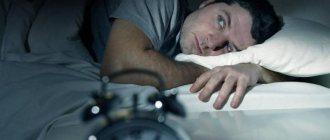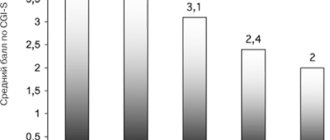Insomnia or, using accepted medical terminology, insomnia is a very common problem. In our turbulent times, few people can say that they have never had problems sleeping. But it is especially unpleasant if sleep disturbances become chronic. Regular lack of normal sleep disrupts the quality of life and harms health. In our country, treatment of insomnia often comes down to the prescription of sleeping pills. Of course, there are a number of cases when it is impossible to manage without drug support. But if a sleeping pill is prescribed thoughtlessly, only on the basis of a patient’s complaint of poor sleep, then it may happen that the medicine will only temporarily suppress the symptoms, but will not eliminate the problem itself.
On the other hand, doctors often have no other way to somehow help a patient with insomnia. Firstly, the time of a standard outpatient appointment often does not allow a detailed understanding of the causes of sleep disturbance. Secondly, most clinics and hospitals simply do not have sleep medicine specialists. There is a lack of knowledge about the diagnosis and treatment of sleep disorders. As a result, doctors are often unable to make an accurate diagnosis and prescribe effective treatment.
But let's turn to foreign practice. American and European sleep specialists consider so-called cognitive behavioral therapy as the first line of treatment for chronic sleep disorders.
How does CBT-B help overcome insomnia?
Let's look at a specific example that provides some techniques for working to improve sleep.
Christina, a swimming and safety instructor, came to the doctor with insomnia. Her story: “After knee surgery, I had to take medication for excruciating pain that made me sleepy. My doctor recommended bed rest. It is difficult to lie in bed without sleep all the time, and I began to sleep not only at night, but also during the day. As a result, daytime sleep was significantly disrupted at night. Over time, the pain in my knee finally went away, I returned to my work, but discovered that the insomnia remained.”
After the injury, Christina returned to her normal life and reduced her daytime sleep, however, upon returning home, she still wanted to sleep. The girl went to bed earlier and earlier. It would seem that for a person whose morning begins at 4:00, falling asleep early is the norm; however, the complexity of the situation was that Christina rarely slept at night without waking up, and then, accordingly, felt tired all day.
The first step in treatment was medication. Various prescription medications didn't help until her doctor prescribed Ambien (a Z-hypnotic sleeping pill). After starting to take Ambien, the girl no longer experienced lethargy during the day, and her nighttime sleep was complete. Christina was finally asleep. But with taking the drug, a new problem appeared: Ambien is indicated for short-term treatment of insomnia, and for Christina, a short-term problem became a long-term one. The only sure way out of this situation is non-drug treatment.
The attending physician suggested that the girl see a psychotherapist, a specialist in cognitive behavioral therapy for insomnia. Despite the fact that at first the reluctance to admit the mental problem of her condition repelled her from the doctor’s proposal, the desire to get rid of her illness won out, and Christina decided to seek the help of a specialist.
General information
Insomnia is a disorder of the sleep-wake cycle. Pathology is determined by a deficiency in the quality and quantity of sleep, which are necessary for normal human functioning. The disease occurs in 30-45% of the world's population. For some of them (10-15%), insomnia is a serious problem requiring medication. It should be noted that with age, problems with falling asleep and maintaining physiologically sound sleep arise more and more often, so older people experience insomnia more often than young people.
Insomnia, a more popular name for the pathology, used by patients and even doctors, is incorrect, since the disease is not accompanied by a complete loss of sleep.
“Whoever falls asleep the fastest gets $100.” Dealing with Negative Beliefs
During her nightly insomnia, Christina developed a fear of going to bed in the evening and worries about how the next night would go. Frustration over lack of sleep made her suffer, and suffering, in turn, only prolonged her wakefulness.
At the session, the psychotherapist explained to Christina that the absence of fear of insomnia is the path to normalizing falling asleep. Fear is stressful, therefore a person cannot fall asleep until he relaxes.
The doctor described an experiment in which healthy participants, divided into two groups, were given a task before going to bed. The task of the first group was to ensure that its participants slept as usual. And the task for the second group was: “whoever falls asleep the fastest will receive 100 dollars.” According to the results of the experiment, it turned out that in the second group the time to fall asleep was on average 20 minutes longer than in the first group. Why did it happen? Falling asleep is a passive process; to fall asleep you do not need to make any effort. Any active actions or thoughts about how to quickly fall asleep lead to excitement, anxiety and prevent you from falling asleep.
The psychotherapist offered Christina a set of exercises to relax and work with restless thoughts that prevent her from falling asleep. The girl performed it every day, and her fears decreased significantly.
Classification of insomnia
According to the duration of its occurrence, insomnia is divided into:
- Transitional, lasting no more than a few nights
- Short-term (from several days to weeks)
- Chronic (three weeks or more)
Insomnia is also divided into physiological (situational) and permanent (permanent). Based on its origin, a distinction is made between primary insomnia, which occurs as a result of personal or idiopathic (unexplained) causes, and secondary insomnia, which occurs against the background or as a result of psychological, somatic and other pathologies.
According to the severity of clinical symptoms, insomnia is:
- Mild (weakly expressed) – rare episodes of sleep disturbance
- Moderate severity – clinical manifestations are moderately expressed
- Severe – sleep disturbances occur every night and have a significant impact on daily life.
Sleep restriction therapy
CBT-B worked, but it was not quick or easy. For the first six weeks, Christina slept less than before. After analyzing the sleep diary, the psychotherapist explained that the girl needed to stop napping during the day and falling asleep early in the evening (experts call this sleep restriction therapy as one of the main components of CBT-B).
Christina was used to going to bed early, but the doctor categorically forbade her to do this before midnight. These were the most difficult six weeks in the girl’s life, as she herself later admitted.
Dr. Michael Perlis, assistant professor of psychiatry and psychology at the University of Rochester, says about CBT-B therapy: “During this phase of therapy, you may feel worse than usual during the day. After a few days of being very sleepy before going to bed, you should fall asleep quickly. This is exactly our goal."
Over time, Christina began to note in her diary that her sleep had improved significantly. The therapist gradually began allowing her to go to bed earlier.
Which doctor treats insomnia?
Diagnosis of a sleep disorder is carried out by a psychotherapist or somnologist. Based on the results obtained, a treatment regimen is selected.
Diagnostic measures include:
- Collecting the patient's medical history.
- Keeping a sleep diary.
- Physical diagnosis.
- Polysomnography is a study of sleep phases using special computer equipment.
- Laboratory diagnostic methods (blood and urine tests).
- Careful collection of anamnesis with assessment of the person’s chronobiological stereotype.
Stimulus control
Another rule of CBT-B is called “Stimulus Control.” These are instructions that doctors draw up after they have studied the patient’s habits and determined what exactly is preventing him from sleeping. The therapist gave Christina the following instructions:
- not spending time in the bedroom when she is awake;
- leaving the bedroom when she couldn't sleep;
- do not return to bed until she feels sleepy.
CBT-B includes training in sleep hygiene and individual selection of activities that need to be performed in order to sleep. For example, sleeping in a cool, dark room and avoiding caffeine, alcohol and tobacco before bed. Sleep hygiene education is most useful when it is based on an analysis of the patient's sleep and wake behavior. Analysis of this information allows the doctor to individually approach the patient with a critical revision of the rules of CBT-B if necessary.
When your doctor reads your sleep diary, they can see what in your lifestyle is interfering with your sleep. One of the common problems that affected Christina is clock watching: many people with chronic insomnia begin to obsessively watch the clock all night.
The therapist forbade Christina to look at the clock, so she removed all the clocks from the bedroom, leaving only the alarm clock.
A good trick is to put an alarm clock under your bed to rid yourself of the temptation to constantly look at it. If a person constantly looks at his watch, he begins to worry and worry that he is still awake. If he doesn’t worry, he calms down faster and falls asleep.
The ban on daytime naps was the most difficult task for Christina.
The therapist also told Christina about the importance of stopping work closer to the night, which only stimulated her and did not calm her down. The girl stopped working before bed, instead she began reading, drawing and learning how to relax. Working late, watching TV or constantly surfing the Internet only invigorates, not calms. Unintentionally, a person trains himself to associate his bedroom with being awake.
After the first six weeks of CBT-B, Christina found that she began to sleep significantly better. Although her appointments with the therapist stopped, she continued to follow her CBT-B regimen. After the end of the CBT-B session, the girl said: “I know that there is a possibility of returning to that difficult state from which I got out with difficulty and not without help, but now I know what to do if the insomnia returns, and I also know that I can always turn to my psychotherapist.”
And another quote from Christina: “I came with the hope of getting rid of insomnia, but I did not expect that her cognitive behavioral therapy would show such a great result! Now I can fall asleep on my own, without pills. For me, this therapy has become a great and long-awaited gift!”
Treatment of insomnia
Transient insomnia usually goes away on its own or after eliminating the causes of its occurrence. Subacute and especially chronic insomnia require a more careful approach, although treatment of the root cause is a fundamental factor.
Successful relief from insomnia involves maintaining sleep hygiene. Falling asleep at the same time every day, avoiding daytime naps, and being active during the day can completely relieve insomnia in older people without the use of medications.
Psychotherapy can eliminate psychological discomfort and restore sleep. Acupuncture and phototherapy (high-intensity white light treatment) have shown good results in the treatment of insomnia.
The use of sleeping pills promotes rapid sleep and prevents frequent awakenings, but hypnotics have a number of adverse effects, ranging from addiction to dependence and rebound effects. That is why drug treatment of insomnia begins with herbal preparations (motherwort, mint, oregano, peony and other medicinal herbs that have a sedative effect) and products containing melatonin. Drugs with a sedative effect (neuroleptics, antidepressants, antihistamines) are prescribed to increase sleep duration and reduce physical activity.
The drugs imidazopyridines (zolpidem) and cyclopyrrolones (zopiclone) have a short duration of action and do not cause post-somnia disorders - these are among the safest chemical hypnotics. A group of tranquilizers - benzodiazepines (diazepam, lorazepam) inhibit brain processes to a greater extent, thereby reducing anxiety and increasing latency to sleep. These drugs are addictive, seriously affect the speed of reaction, and at the same time enhance the effect of barbiturates and analgesics.
Rules for taking medications for insomnia include: compliance with the duration of treatment with sleeping pills - on average 10-14 days (no more than 1 month); drugs can be prescribed in combination, taking into account their compatibility; one or another drug is selected depending on the concomitant somatic pathology and the minimum set of side effects. For preventive purposes, sleeping pills are prescribed 1-2 times a week. It is important to understand that the use of sleeping pills is purely symptomatic treatment. This fact and the mass of undesirable consequences force us to limit their use as much as possible.
Electroson
This is a method of electrotherapy, which is based on the use of low-frequency pulsed currents. Electrodes are attached to the eyelid and the current is transmitted through the vessels of the eye to the brain, having a calming effect on the nervous system. This creates a state similar to sleep. Electrosleep differs from medicinal sleep and does not cause complications or intoxication of the body. Carbohydrate and lipid metabolism increases in the tissues and cerebral cortex, and blood nourishes the brain more intensively.
The electrosleep method is carried out using the Electrosleep ES-10-5 physiotherapeutic device. The Electroson device provides the generation of low-frequency rectangular current pulses in continuous operation. The vibrations are supplied through the electrodes of a special mask, which is applied to the area of the eye sockets and the back of the head.
Causes
Predisposing conditions include biological components:
- genetic predisposition;
- etiological factors;
- increasing metabolic rate;
- high tone of the sympathetic nervous system.
Scientists have received convincing evidence that a predisposition to insomnia can be passed on from ancestors to descendants, most often through the maternal line. This heredity is explained by the special structure of the brain, namely the excessive activity of systems that regulate reactions to stress (the hypothalamic-pituitary-adrenal axis). But in addition to genetic factors, a person’s social environment, behavior learned from parents, and the presence of psychopathological qualities and accentuations in the personal portrait have a huge influence character, increased anxiety.
The main provoking factor is powerful stress. The manifestation of the disorder often occurs after severe stress, when a person is forced to change his lifestyle due to a radical change in circumstances.
Supporting factors include the formation of dysfunctional ideas about sleep and the emergence of abnormal behavioral reactions, for example, an increase in time spent in bed.
Prevalence
It is estimated that about 10% of the human population suffers from chronic insomnia. Periodic, short-term, transient sleep disturbances are recorded much more often - in 30% of the world's inhabitants.
At the same time, the number of people complaining of insomnia is increasing every year. This is most likely due to the rapid acceleration of the pace of life of contemporaries, excessive mental and mental stress, and lack of physical activity. Most of the patients are residents of large industrial cities. In rural areas this problem is encountered very rarely. Most patients diagnosed with insomnia are engaged in mental work and lead a sedentary lifestyle. Sleep disorders are recorded 1.5 times more often in females, which is associated with a more subtle organization of their emotional world.
As a rule, insomnia is a typical phenomenon in the category of people who do not have a regular income, do not work, or abuse alcohol. Sleep problems can occur at any age. However, insomnia more often occurs in older people who have serious health problems.










